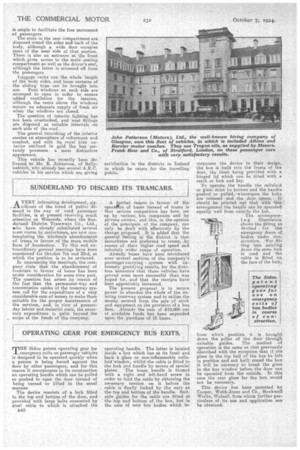OPERATING GEAR FOR EMERGENCY BU ' S EXITS.
Page 22

If you've noticed an error in this article please click here to report it so we can fix it.
IT1HE Sidno patent operadng gear for _I emergency exits on passenger vehicles is designed to be operated quickly when a person is being forced against the door by other passengers, and for this reason it incorporates in its construction an operating handle which can be polled or pushed to open the door instead of being turned or lifted in the usual manner.
The device consists of a lock fitted to the top and bottom of the door, and provided with large bolts connected by steel cable to which is attached the 3340 operating handle. The latter is located inside a box which has at its front and back a glass or non-inflammable cent'. bid window, whilst the cable is fitted to the lock and handle by means of special plates. The brass handle is formed with a right and left-hand screw in order to hold the cable by obtaining the necessary tension on it before the cable is finally locked by the nuts at the top and bottom of the handle. Suitable guides for the cable are fitted at the top and bottom of the box, but in the case of new bus bodies which in corporate the device in their design, the box is built into the frame of the door, the front being provided with a hinged lid which can be fitted with a, catch or lock and key.
To operate the handle the celluloid or glass most ha broken and the handle pushed or pulled, whereupon the boltS are released and the door,,opens. should he pointed -out that with thiS arrangement the handle ca-n be operated equally well from outside the bus..
The accompany; in g illustration shows the fitting as devised for " the emergency doors of bbdies 'under con:struction. -For fitting into existing doors the same be is used and the cable is fitted on the face of the lock,
from which position it is brought down the pillar of the door through suitable guides. The method of operation is the same as that previously described with the exception that if the glass in the top half of the bus be left in position and -not built round the boar it will be necesary to break the glass in the bus window before the door can be operated from the outside, in this case the rear glass for the box would not be necessary. • This device has been patented by Cooper, Webb-Jones and Co., Stockwell Works, 1Valsall, from whom further particulars of its use and application can be obtained.






























